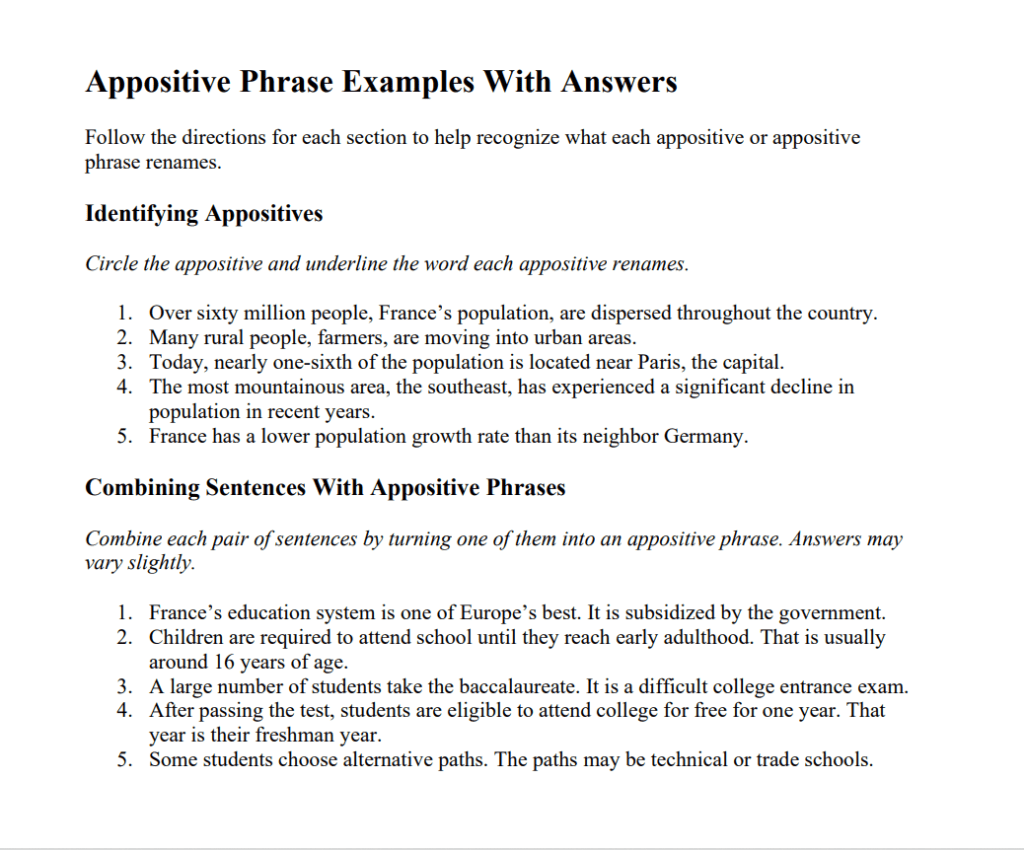In English, there are many grammatical ways to add detail and information to a sentence to help a reader understand what you are trying to say. In Latin, this was called an appose, which means “to put near, side by side, or alongside,” and has been adapted in English composition to provide an additional layer of meaning to a sentence.
Appose is the root word of appositive, a word or phrase that provides an easy way to add to the meaning of nouns and pronouns. See below how easily an appositive is to add to your writing to create more understandable material.
What is an Appositive Phrase?
An appositive is a noun or pronoun placed next to another noun or pronoun to identify, explain, or rename the original. When an appositive is accompanied by its own modifiers, it is called an appositive phrase. These modifiers can be adjectives, adjective phrases, or groups of words that function as adjectives.
What Are the Types of Appositive Phrases?
There are two types of appositive phrases: restrictive and nonrestrictive. They both add detail to a sentence, but how they are used can determine whether they are needed or not. How they should be punctuated is also important and is explained below.
Restrictive Appositives
A restrictive appositive or appositive phrase (also known as an essential element) must be included in the sentence to provide essential information a reader needs to know about the noun or pronoun.
For example, providing an individual’s identity in a sentence would make their name a restrictive appositive.
- My teacher Mr. Smith was a Vietnam veteran and provided insight into this period in history class.
Nonrestrictive Appositives
A nonrestrictive appositive or phrase (also known as a nonessential element) is unnecessary and does not take away from the overall understanding of the sentence when left out.
For example, defining your relationship to a person in a sentence is considered nonessential to the overall understanding of the sentence.
- Mr. Smith, my teacher, was a Vietnam veteran and provided insight into this period in history class.
Rules of Appositive Phrase Use with Examples
Appositives are easy to include in writing and have very few rules associated with their use. Remember the following simple rules to include descriptions and details that can help clarify your writing.
Rule #1
Appositives follow immediately after the words they identify, rename, or explain.
For example:
- Her greatest attribute, kindness, was not enough to keep him from leaving.
Rule #2
An appositive phrase contains adjectives, adjective phrases, or groups of words that work as modifiers.
For example:
- Susan explained geocaching, the hobby of real-world treasure hunting using GPS locations.
Rule #3
Appositives and appositive phrases can be compound.
For example:
- Fred, his schoolmate and team member, was the only person he trusted with dog-sitting.
Rule #4
Appositives and appositive phrases can combine sentences and help eliminate unnecessary words.
For example:
- Rome is thousands of years old and is located in Italy. The city is an important cultural center.
Using appositive phrases allows you to remove unneeded wording and create compound sentences.
- Rome, an important cultural center in Italy, is thousands of years old.
How to Punctuate Appositives
Appositives have a few simple rules of punctuation to remember as well. These deal with appositive commas, semicolons, colons, and em dash rules to offset the information provided.
Punctuation Rule #1: Commas
Do not use a comma to offset restrictive appositives in a sentence
For example:
- My friend Mark went to the store for dinner ingredients.
Use a comma to offset nonrestrictive appositives in a sentence.
For example:
- Mark, my friend, went to the store for dinner ingredients.
Punctuation Rule #2: Semicolons
Use a semicolon to separate nonessential appositives listed in a series when a comma is already included.
For example:
- I sent a thank you card to Dr. Smith, my surgeon; Mark, my therapist; and Donna, my friend, that drove me to all my appointments.
Punctuation Rule #3: Colons
Use a colon to introduce an appositive that follows an independent clause. This provides an additional emphasis on the appositive.
For example:
- We decided on the perfect movie spot: the old, refurbished drive-in.
Punctuation Rule #4: Em Dashes
Use em dashes to offset nonessential modifiers within a sentence if it is already punctuated, when it is long, or when you want to add a dramatic tone.
Internally Punctuated
For example:
- Some students — for example, Monica, Susan, and Maria — have formed a book club for each assigned book.
Length
For example:
- The assigned books — often set in a historical period to help further understand the subject studied — were generally very lengthy.
Dramatic Tone
For example:
- The subjects — fascinating and complex — required a lot of critical thinking and discussion.
Let’s Review
Appositives and appositive phrases follow nouns and pronouns to add information and further reader understanding. They work to identify, explain, or rename the original noun or pronoun term, and can even contain their own modifiers.
Some appositives are essential and must be included to avoid confusion, while others are simple, nonessential additions that add detail rather than clarification. Always be sure to apply proper grammar structure surrounding their use.
WORKSHEET

